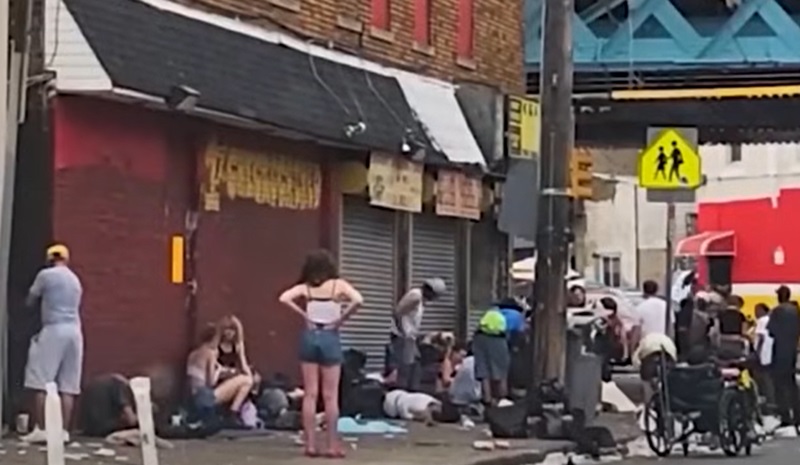
By Steve Pomper
Local governments make police work harder when they impose harmful policies, carving out special treatment for the so-called, “homeless,” or this new one, “unhoused.”
When I got a burglary call near a “homeless” camp, it didn’t take Sherlock Holmes to know where to start looking for suspects. Was I “profiling?” Well, what would you call it when you glance over at the tents and makeshift shacks under a nearby overpass and see household items, chainsaws, barbeque grills, and yard tools scattered about?
So, who is responsible for “houselessness” getting worse rather than better? It’s not hard to figure out, since we’re talking about “blue” cities. The culprits are in plain sight. Whether it’s the well-meaning liberal, or ideological activists, or the cash cow-milking Homeless Industrial Complex (HIC), the so-called “harm reductionists” are not reducing harm. In fact, more Philadelphians now believe these HIC soul-suckers are causing it.
On a sidenote, some residents believe there’s a racial angle to this houselessness/Fentanyl crisis, but not it’s what you might think. And, though I’m not entirely convinced, I understand the critics’ perspective.
The optics over recent decades, regarding urban “houselessness,” showed while (mostly) black crackheads were arrested, today, many local governments prevent cops from arresting (mostly) white fentanyl addicts.
These residents have also observed a significant number of houseless activists, supporters of destructive urban policies, tend to be white.
Olivia Reingold, at The Free Press, interviewed a mother of three, Sonja Bingham, who lives in Philadelphia’s Kensington neighborhood. Bingham contrasted local governments’ handling of the past “crack epidemic” compared to the current “Fentanyl epidemic.” She told Reingold, bluntly, “They threw our black asses in jail.”
Bingham elaborated. “Now that the color of the addicts has changed [from black to white], they’re [activists] going to meet them [addicts] where they are in our community and allow them to destroy it. So, now you have the children, grandchildren, great-grandchildren, watching how once again, our lives don’t matter.”
I’d argue, there were reasons other than racism, but I got the impression that she wasn’t simply condemning that “They threw our black asses in jail.” She seemed to be frustrated that “They don’t throw their white asses in jail.”
Back when I was dealing with the crack problem in my city, we may have arrested dealers and users, but they didn’t stay in jail for very long, anyway. We were in the nascent stages of the lawless blight we live with today in too many places.
Personally, I believe it’s an economic class and traditional values thing, not a racial thing. But I have sympathy for her “lived experience.” Sorry.
The irony is, the houselessness activists who preach their concern for the “BIPOC” residents, don’t seem to practice it. They care about pushing their radical ideology and keeping the financial spigot flowing more than about finding effective solutions.
While the woke activists, aka, “harm reductionists” believe they are sanctified problem solvers, residents say, “the activists are actually the ones causing it.”
As much as people want to downplay simple drug use as an individual choice, society cannot ignore public drug abuse attracts drug dealers, many violent and some associated with the drug cartels. They go where their “customers” are—to houseless camps. Even if you don’t want to arrest people for drug use, what about arresting them for the crimes they commit to get their drugs? If you don’t support that, you’re intentionally increasing harm.
Not surprisingly, Bingham says the activists “vilify” any resident “who complains about the nonprofit workers and volunteers who hand out millions of free syringes a year in Kensington using public dollars….” This vilification tactic by activists is routine, despite parents are justifiably concerned about their kids getting a needle stick while playing in a park.
Also, not surprising, she cites part of the vilification is their reflexive accusations that the frustrated residents who dare to complain “don’t care about people or we’re racists.” She notes that most of the residents are minorities, but “many of the activists handing out sandwiches and needles… are white.”
Warped social justice concepts like “harm reduction,” “housing first,” and “restorative justice,” simply don’t work. How do I know? Because I spent a couple decades as a cop watching them not work. Now, I’ve been retired for a decade and I’m still watching them not work.
It also doesn’t help that Philly has one of the most destructive Soros-funded district attorneys in the nation. Larry Krasner’s criminal injustice system has been addressed by the NPA over the years. This includes his woke-handling of cases, including those involving murdered Philadelphia police officers.
The “harm reductionists” have been “trying” it their way for years without success. Hold up. Let me clarify that. These policies “don’t work” if you want to effectively combat addiction, houselessness, mental illness, and the associated crime. But, if the harm reductionists have been working to make the problem worse, then hip-hip-hooray!
And they’ve done it while spurning ideas from anyone who doesn’t think—exactly—like them. They won’t even listen those whose ideas have worked elsewhere. That’s one reason this issue is so frustrating. Not every city, county, or state is experiencing these issues at crisis levels. Houselessness, public drug use, mental illness, and crime occur in every city. But there’s a reason why in some cities, these are manageable issues while other cities they are catastrophic.
You don’t have to look further than a far-left Washington Post article for confirmation. “Here, too, there’s a big divide between red and blue states: In blue-state major cities, the homeless population rose since 2011 while, in red states, major city homeless numbers dropped steadily.”






